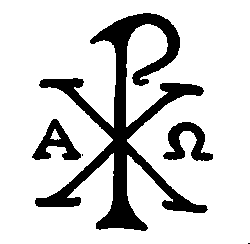TWENTY-FIRST SUNDAY IN ORDINARY TIME (A)
Tu est Petrus, et super hanc petram aedificábo Ecclésiam meam… This is the first part of the antiphon we hear at Mass today before the gospel reading. It quotes from the gospel itself (Mt 16:13-20), which in English says, “You are Peter and upon this rock I will build my Church and the gates of the netherworld shall not prevail against it.” This iconic passage takes place at Caesarea Philippi, a place the gospel writer mentions specifically. If you do a Google image search on line you can see this place. There is a huge stone outcropping with a temple built upon it to the pagan god Pan. It is by this backdrop that Jesus changes Simon’s name to Peter (which means “rock”) and says, “upon this rock I will build my Church.”
This is obviously a very key moment in the gospels, and so it is important to consider just what is happening here. This passage is foundational to our understanding of the Church, for Christ tells us not only that He intends to found His Church upon a person (Peter), but also what sort of authority that person will have. “I will give you the keys to the kingdom of heaven. Whatever you bind on earth shall be bound in heaven; whatever you loose on earth shall be loosed in heaven.”
The Church also gives us today an Old Testament reading from Isaiah 22:19-23 which speaks of keys being given to convey authority. “I will place the key of the House of David on Eliakim’s shoulder; when he opens no one shall shut, when he shuts no one shall open. I will fix him like a peg in a sure spot…” There is obvious similarity between this and our gospel reading. What is the significance?
In the history of Israel, there developed the office of prime minister. This person had the authority to rule over the kingdom in the absence of the king. It was an office that could be passed on from one generation to the next, symbolized by keys. What we read in our passage from Isaiah today is God passing on the authority of the prime minister of the Davidic kingdom from Shebna to Eliakim. It is no coincidence that Jesus uses the same symbol of keys, and nearly the same phraseology, to establish the prime ministerial office of His Kingdom upon Peter, an office which can be passed on from one generation to the next. The enduring nature of this office is implied when Christ promises that the gates of hell will not prevail against His Church.
Instead of “opening” and “shutting” as we hear in Isaiah, Jesus speaks of the power to “bind” and “loose.” This phraseology would also have been familiar to the Jewish people. It signified to them the authority to teach and render binding decisions on the law, and the authority to include or exclude people from the community. It also signifies the forgiveness of sins. This is why even to this day we speak of the authority of the Church to teach, govern and sanctify (Catechism of the Catholic Church 888-896).
There is something about this passage, however, which can easily be overlooked in English translation. Many languages have different words for the second person pronoun depending on whether it is singular or plural. English uses “you” for both. If we were reading this passage in Spanish, or more to the point, the original Greek, we would see that Jesus uses the singular “you” when He tells Peter, “I will give you the keys to the kingdom of heaven.” But Jesus uses the plural “you” when He says, “Whatever you bind on earth shall be bound in heaven, and whatever you loose on earth shall be loosed in heaven.” In other words, Peter alone possesses the keys of the kingdom (symbolizing the prime ministerial authority), but the Apostles together with Peter possess the power to bind and loose (CCC 881).
What does all this mean for us in the Church today? How does this authority granted to the Church by Christ play out in history? We can give one very prominent example dealing with the scriptures themselves. From the very beginning, the liturgies of the early Church included readings from sacred scripture. These included readings from the Hebrew Bible, what we call the Old Testament, but very quickly also included readings about Jesus and the teachings of the new Christian Church. These would include gospel accounts of Jesus’ life and mission. These would also include letters written by the Apostles to various people and Christian communities. However, there was no set “New Testament.” There was no authoritative list of which books were inspired by God and which were not.
This led to some variation in what texts were read from during the liturgies. To ensure unity in worship, local bishops, utilizing their authority as chief shepherds of their particular churches, began to keep lists of books which were approved for liturgical use in their church (what we would call a diocese today). The earliest such lists that we know of date to the end of the second century. But still, this meant that different texts were considered canonical in one region but not in another. This became problematic for the universal Church as different heresies arose, especially Gnosticism. The Gnostics would write their own gospels, containing teachings rather contrary to the Apostolic faith, which would circulate and lead to confusion among the faithful. (If you watch the Discovery Channel or the History Channel around Christmas and Easter you often see documentaries on “The Lost Gospel of Judas,” or “The Lost Gospel of Thomas.” These are Gnostic gospels, not lost Christian gospels The Church has known about them for about 1700 years, so no one should have their faith shaken by their existence.)
And so regional councils of bishops together met and discussed which books should officially be included in the canon of the Bible. Two councils, at Hippo in 393 AD and Carthage in 397 AD, would approve the list of 73 books which are still contained in the Catholic Bible today. These were local councils (not full ecumenical councils of the Church), and so their decrees are not binding on the universal Church. So in the year 405, Pope Innocent I, successor of St. Peter, affirmed the same list of 73 books. The case was closed, so to speak, from that point forward until the Protestant Reformation when Martin Luther and his followers questioned the legitimacy of certain Old Testament books (what Catholics call the deuterocanon and Protestants call the apocrypha) and removed them. The Council of Trent (1545-63), a full Ecumenical Council of the Church, exercising the teaching authority of all the bishops united with the pope, reaffirmed the canon of 73 books in the face of this controversy.
And so the very reason we have the scriptures that we do today, and the faith that they contain the inspired Word of God, is due to the exercise of the teaching authority to bind and loose that Christ gave to Peter, His “prime minister,” and to the Apostles. This is why St. Augustine could say, “I would not believe in the gospel if the authority of the Catholic Church did not move me to do so” (397 AD).
In the end we all submit ourselves to some authority, even if only the authority of popular opinion. To be true to ourselves and who we were made to be, we should submit ourselves only to the authority of God, the author of all Creation. That authority exists in Christ, His Son, who not only became man but saw fit to allow man to share in that divine authority. That authority has been transmitted from Peter and the Apostles down through the ages right to today with Pope Francis and all the bishops of the Church, including our Bishop of Charlotte, Peter Jugis. It is the same Church that Christ founded upon Peter, teaching the same Apostolic faith, and possessing the same authority from God to lead her people to salvation.
—
WCU Catholic Campus Ministry
Matthew Newsome, MTh, campus minister
(828)293-9374 | POB 2766, Cullowhee NC 28723


